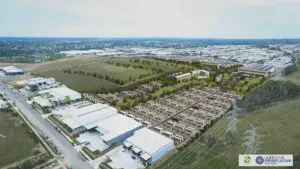The Australian Energy Market Commission is proposing to tighten ring-fencing rules for transmission network companies, in a bid to boost competition for grid connection services and to speed up the rollout of new solar, wind and battery projects.
The AEMC says the draft rule, published on Thursday, would empower the Australian Energy Regulator to develop new rules separating the regulated and competitive business activities of transmission network service providers (TNSPs) when contracting for grid connection services.
A rule change request was submitted by the AER after a 2022-23 review found that the current scope of the Transmission Ring-fencing Guideline does not extend to negotiated transmission services, despite these being provided exclusively by TNSPs.
In the request, the AER says its primary concern is that this gap could allow TNSPs to discriminate when negotiating grid connection services, either in favour of themselves or an affiliate in the contestable market.
The AER warned this could happen in the case of generator connections, where a connecting party is seeking both contestable and non-contestable connection services and the TNSP has the ability to discriminate in favour of generators completing all services with the TNSP (including its related affiliates).
It could also affect distribution network connection applications that require upstream augmentation works on the shared transmission network, when the TNSP could use the information about the new potential connection to its advantage.
“Wherever a single entity provides both monopoly and contestable services in the same or related markets, there is a risk that discriminatory behaviour could occur,” the documents say.
“It is for this reason that ring-fencing controls often apply in these circumstances: to clearly separate out the two sets of services for transparency, helping to enforce non-discrimination obligations.
“Indeed, Flow Power and Engie submitted that the omission of negotiated transmission services from the ring-fencing framework appears to be a regulatory oversight that should be corrected.”
The AER notes that while there has been “significant support” from stakeholders to tighten the regulatory ring-fencing framework by a range of parties, there has also been a reluctance by some to detail their experiences with TNSPs when seeking transmission connections, resulting in a lack of substantive evidence of problematic behaviour.
“Submissions that explicitly supported action being taken to address the perception of discrimination even without definitive evidence included Alinta Energy, ENGIE, Flow Power and Snowy Hydro,” the report says.
“These stakeholders considered that even the perception of harm could be detrimental to the market.”
According to the report, a submission from AGL Energy notes that any lack of evidence might come down to the fact that “it will often not be in the interest of a connecting party to challenge perceived discriminatory behaviour.”
On the transmission company side of the equation, however, the report says “AusNet, the ENA, TasNetworks and Transgrid considered there insufficient evidence to justify amending the regulatory framework.”
A “long, complex” process
Grid connection agreements have been notoriously hard to obtain for Australian wind and solar projects, with problems emerging at various stages of the process.
The AER’s rule change request cites a submission from big three gentailer AGL Energy that describes the existing grid connections framework as “a long, complex [and] highly detailed process.”
The problem was even called out in a recent International Energy Agency report, which included Australia on a list of countries whose forecast renewable energy growth rates have been “reined in” due to a range of speed humps including a failure to keep up regulatory pace with market expansion.
AEMC chair Anna Collyer said this week that as more big solar, wind and storage projects come online, a greater focus is being placed on how generators link into networks.
“Ring-fencing is already in place for most monopoly transmission services, but there is a gap in the framework when it comes to ‘negotiated’ and ‘competitive’ connection services – two services for connecting to the network,” Collyer said.
“Our draft rule suggests a change to the existing framework to provide the AER with the tools needed to address any risk that TNSPs engage in discriminatory behaviour in the market that could adversely effect competition.
“Given the increasing number of generators seeking connection to the transmission system, we do anticipate these changes will help to improve the efficiency of the connection process, delivering savings to consumers and helping to meet our decarbonisation targets.”
The AEMC will hold a forum on 11 March 2024 to provide stakeholders with an opportunity to ask questions and provide feedback on the proposed rule change. Written stakeholder submissions are being accepted until 4 April 2024.










